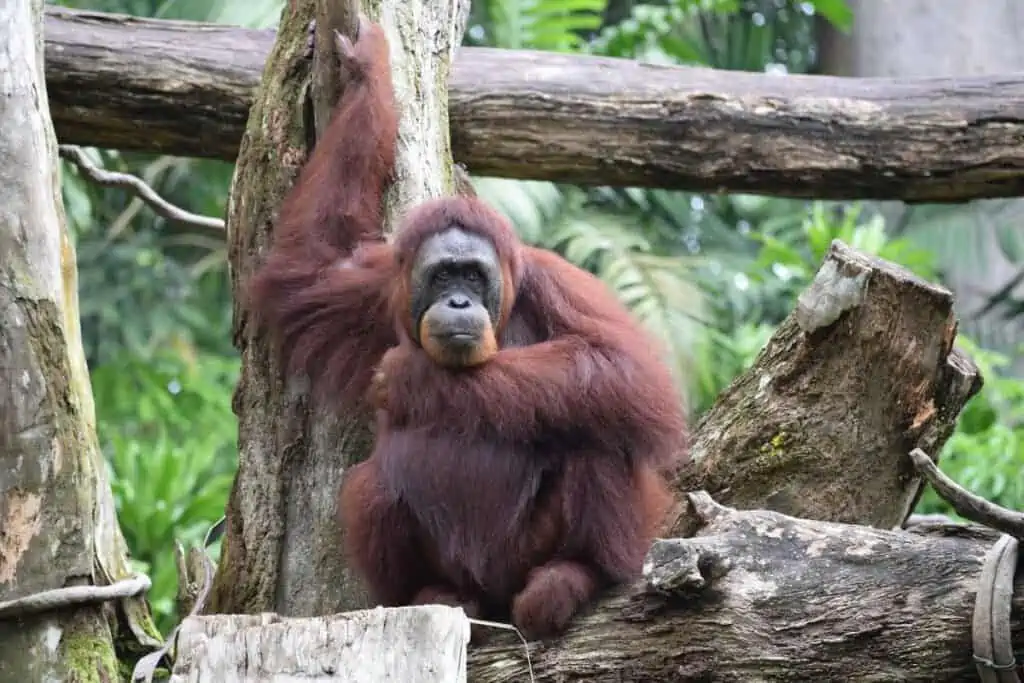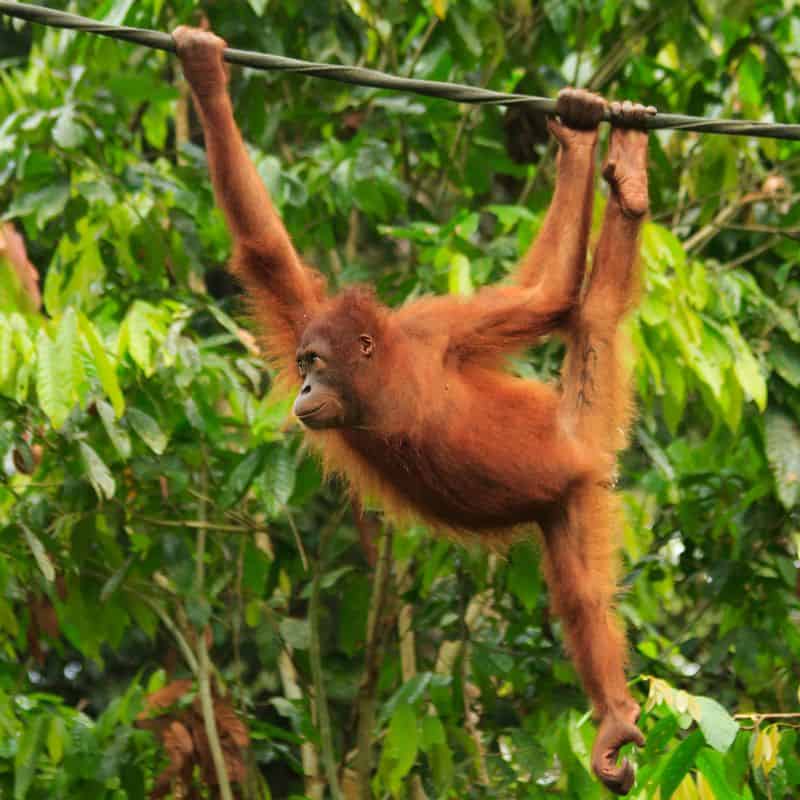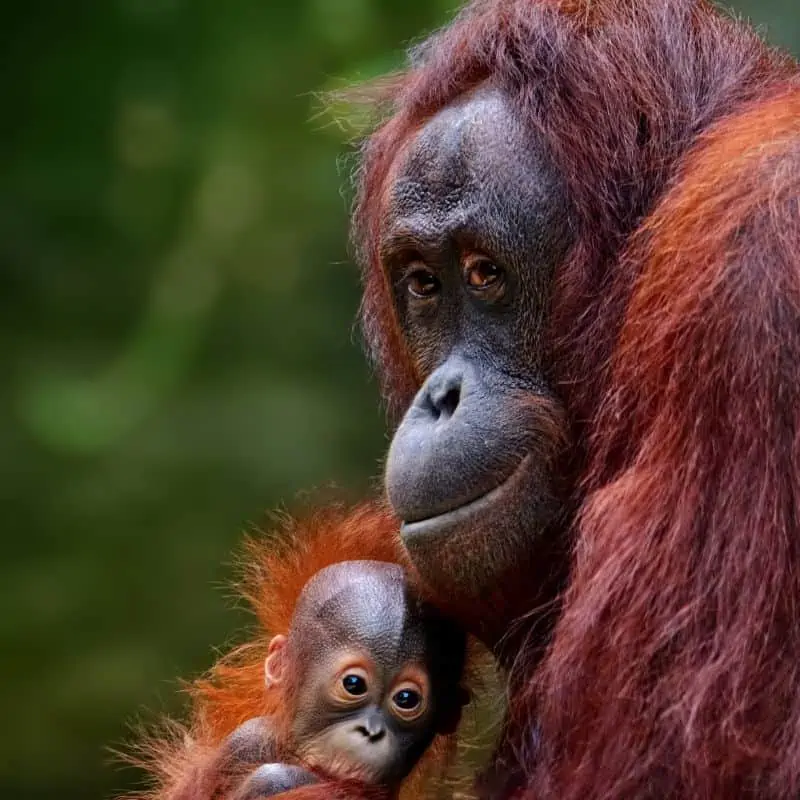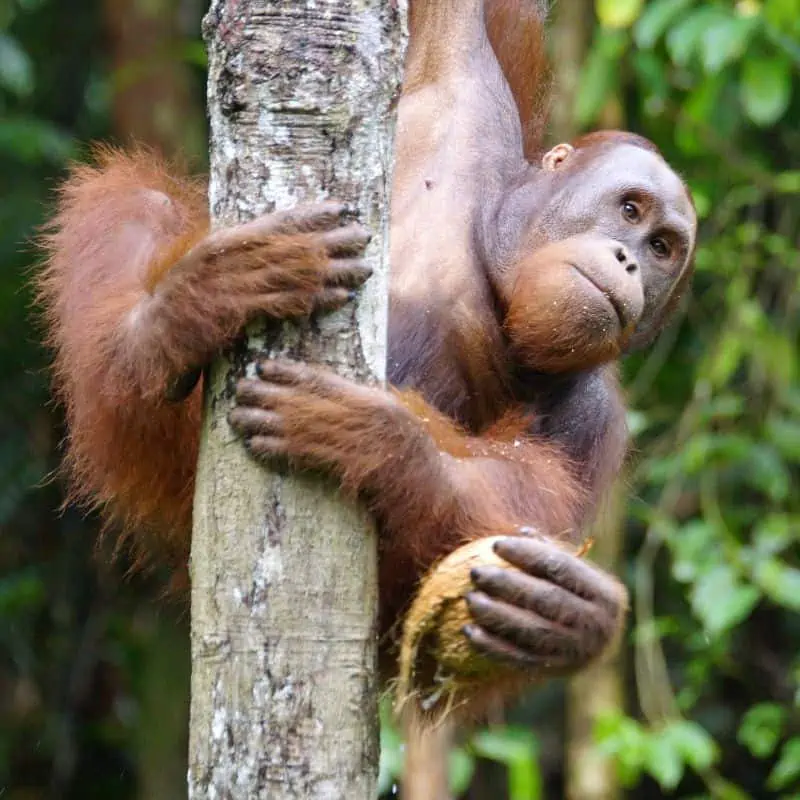Orangutans have furry bodies, climb trees, and look similar to some monkey species. But is an orangutan a monkey?
Orangutans are not monkeys. They do not share the same family due to their absent tails, larger and more sturdy bodies, arboreal lifestyle, brachiating locomotion, longer lifespan, solitary nature, intelligence, and different geographic distribution than monkeys.
Let’s look at why orangutans aren’t monkeys in more detail.

- 10 Reasons Why Orangutans Are Apes, Not Monkeys
- 1. Orangutans Don’t Have Tails
- 2. Orangutans Are Larger Than Monkeys
- 3. Orangutans Are Arboreal
- 4. Orangutans Swing Around While Monkeys Crawl or Run Across
- 5. Orangutan Diet Vs Monkeys
- 6. Orangutans Have A Longer Life Span Than Monkeys
- 7. Orangutans Have Longer Breeding Cycles
- 8. Orangutans Are Solitary
- 9. Orangutans Have Better Cognitive Skills
- 10. You Can See an Orangutan Only in Indonesia or Malaysia
- Final Thoughts On Whether Orangutans Are Monkeys
- FAQs
10 Reasons Why Orangutans Are Apes, Not Monkeys
Orangutans are often mistaken for monkeys, but they are great apes. Great apes include orangutans, gorillas, chimpanzees, and bonobos.
Let’s take a closer look at some differences between orangutans and monkeys.
1. Orangutans Don’t Have Tails
One of the most obvious ways to distinguish between apes and monkeys is by their tails.
All species of apes, including orangutans, do not have tails. On the other hand, all species of monkeys (except for one, the Barbary Macaque) have a tail.
So if you see an animal with a tail climbing tree, odds are it’s a monkey.
2. Orangutans Are Larger Than Monkeys
Orangutans are large compared to most monkeys, with males averaging about 200 pounds and females weighing half to one-third of that.
They have long arms, which they use to swing from tree to tree, and short legs. Their chest is deep, and their shoulders are broad, giving them a hunched appearance.
I’m sure you’ve never seen a monkey the size of an orangutan, gorilla, or chimpanzee because monkeys have smaller bodies with narrow chests, just like medium-sized mammals like cats and dogs.
Some apes, like gibbons, also have small bodies but share the same skeleton structure as other great apes, which places them in the ape category despite their smaller size.
3. Orangutans Are Arboreal
Orangutans are arboreal animals that dwell in trees. They are the biggest tree-dwelling mammals and require little to no descent from a tree due to their adaptation to an arboreal lifestyle.
Their nests may reach heights of up to 120 feet.
Monkeys are generally tree-dwelling animals, although not to the same extent as orangutans.
Many primate species, such as Japanese macaques, have evolved to live in less vegetation and other environments, including hot springs, to regulate their body temperature.
4. Orangutans Swing Around While Monkeys Crawl or Run Across
Orangutans and monkeys both climb well, but they use different techniques.
Apes swing from branch to branch using their long arms (a movement known as brachiating), while monkeys typically crawl or run along the branches.
Apes, including orangutans, have evolved shoulder joints that allow them to brachiate efficiently, and they tend to have a more upright body position than monkeys.
This makes it easier for them to walk on two legs if needed.

5. Orangutan Diet Vs Monkeys
Orangutans are frugivores, which means that they primarily eat fruit. However, they will also eat bark, leaves, and insects (on occasion).
The type of fruit they eat can vary according to the forest conditions and availability of fruits. In general, though, orangutans prefer fruits that are high in sugar content.
Flowers are also part of their diet, although they make up a relatively small percentage compared to fruits and other items.
The diet of most monkeys includes both plants and animals, but they are commonly known to prefer fruit, such as bananas.
Some minerals and meat may also be eaten, like lizards or bird eggs.
Similarly to humans, their diets can change with the seasons.
For example, Probosci’s monkeys consume ripe fruits from January to May and progressively eat more leaves from June to December.
6. Orangutans Have A Longer Life Span Than Monkeys
In the wild, orangutans have a life expectancy of approximately 30 to 40 years.
Some researches also reveal that male orangutans can live up to 58 years in the wild, while female orangutans can live up to 53 years.
In captivity, however, the average lifespan may reach 60.
In contrast to orangutans, monkeys have a somewhat shorter life expectancy, but the lifespan is significantly varied across species.
Here are the typical lives of the most well-known monkey species for comparison:
- Baboons are believed to live the longest among all monkey species, with an average life span of 30 years in the wild.
- Spider monkeys have an average life of 22 years in the wild.
- Golden Bodied Capuchins can have a life of 30 years in the wild.
Monkeys have a wide range of life expectancies, which makes keeping track of them extremely difficult. However, they do not live as long as orangutans.
7. Orangutans Have Longer Breeding Cycles
Orangutans have a very slow reproductive cycle. Wild orangutan females first reproduce at a mean age of 15.4 years, with an age range of 13-18 years. They have a mean interbirth interval of 9.3 years. This means they give birth to one infant every nine years on average, with a rare chance of producing twins.
In captivity, orangutan females regularly begin reproducing at seven and have interbirth intervals that can be shorter than one year.
Most monkey species give birth continuously throughout the year. However, those that live farther from the equator generally have births associated with seasons.
For example, the Sykes Monkey’s reproductive cycle is seasonal and linked to changes in rainfall.
Conceptions and births happen during periods of little rain, while pregnancy and lactation occur more often during heavier rainy seasons. Most of the population breeds at any given time – around 54.5%.
The interbirth interval varies a lot from specie to specie for monkeys like spider monkeys will breed after two to four years again

8. Orangutans Are Solitary
These enormous gentle giants dwell in Indonesia and Malaysia’s rainforests. You can’t see them forming social groups until they have chosen their mating partner.
In contrast, monkeys are social creatures that usually live together in large groups or troops.
A typical monkey troop consists of one adult male and several adult females, along with their offspring (known as the one-male group).
The adult male is the leader of the group, protects the others from outsiders, and has access to all females of the group as long as he is in charge.
9. Orangutans Have Better Cognitive Skills
Orangutans are some of the smartest primates, with abilities that match humans in certain ways. For example, they have been known to construct and use tools to solve problems.
Also, they demonstrate an understanding of space and memory similar to ours.
Orangutans are also believed to communicate using their own language, known as long calls, which incorporate unique vocal noises and can be heard 1.2 miles away.
Furthermore, orangutans have been shown in studies to be able to learn human-made languages, indicating a high level of intellect.
When we compare monkeys to apes, it’s evident that monkeys have fewer cognitive abilities and aren’t as great at using or understanding language.
Nevertheless, they can still communicate quite efficiently through sounds and body language.
Monkeys can remember past events, which allows them to make more informed decisions in the present moment.
10. You Can See an Orangutan Only in Indonesia or Malaysia
The tropical forests of Southeast Asia are home to orangutan species.
- Sumatran orangutan is only found on Sumatra
- Bornean orangutans prefer lowland rainforests and tropical, swamp, and mountain forests on Borneo’s island.
- Tapanuli orangutan only exists in North Sumatra’s three Tapanuli districts within the Batang Toru Ecosystem.
Monkeys are found in Central and South America, Europe, Africa, and Asia.
- In America, monkeys are found in tropical and subtropical regions.
- In Africa, monkeys are found in tropical rainforests.
- In Asia, monkeys are found in forests, woodlands, and grasslands.
So if you happen to see any primate in the wilds of America, it won’t be an ape.

Final Thoughts On Whether Orangutans Are Monkeys
Orangutans and monkeys are not the same species. In reality, they don’t even belong to the same family owing to several distinctions such as the presence or absence of tails, sizes and body masses, lifestyles, and locomotion.
Orangutans and monkeys also contrast in their diets, life spans, reproduction cycles, and social behaviors.
Even though monkeys are quite intelligent, orangutans have the upper hand here.
Orangutans are only found in Indonesia and some parts of Malaysia, while monkeys can be seen almost worldwide.
FAQs
Are Orangutans and Monkeys the Same?
For a long time, humans thought monkeys and apes were the same, but they’re not.
Orangutans differ from monkeys anatomically and lifestyle-wise in terms of feeding habits, reproduction rate, longevity, and cognitive capacity.
What Makes a Monkey a Monkey?
The majority of monkey species have tails, with a few exceptions. They also boast short bodies, narrow chests, and flat faces.
Their skeletal system is similar to that of small mammals like dogs and cats, which allows them to walk and run efficiently.
All these factors differentiate monkeys from apes.
Is An Orangutan An Old World Monkey?
No, orangutans and old-world monkeys both belong to different families. Orangutans belong to the family Hominidae while old-world monkeys belong to the family Cercopithecidae.
Although old-world monkeys are more closely related to apes, they are not the same family phylogenetically.
